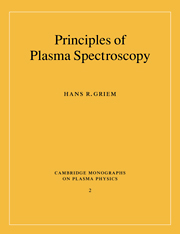Book contents
- Frontmatter
- Contents
- Preface
- Symbols
- 1 Classical theory of radiation
- 2 Quantum theory of radiation
- 3 Oscillator and line strengths
- 4 Spectral line broadening
- 5 Continuous spectra
- 6 Cross sections and level kinetics
- 7 Thermodynamic equilibrium relations
- 8 Radiative energy transfer
- 9 Radiation losses
- 10 Spectroscopic density measurements
- 11 Spectroscopic temperature measurements
- 12 Other diagnostic applications of plasma spectroscopy
- References
- Index
7 - Thermodynamic equilibrium relations
Published online by Cambridge University Press: 29 August 2009
- Frontmatter
- Contents
- Preface
- Symbols
- 1 Classical theory of radiation
- 2 Quantum theory of radiation
- 3 Oscillator and line strengths
- 4 Spectral line broadening
- 5 Continuous spectra
- 6 Cross sections and level kinetics
- 7 Thermodynamic equilibrium relations
- 8 Radiative energy transfer
- 9 Radiation losses
- 10 Spectroscopic density measurements
- 11 Spectroscopic temperature measurements
- 12 Other diagnostic applications of plasma spectroscopy
- References
- Index
Summary
In view of the complexity of the various kinetic models discussed near the beginning of the previous chapter and of the vast array of cross sections and other atomic data required for their implementation, there is a great need for a more basic theory. Such a theory will have a restricted region of validity but can be used with confidence for the interpretation of plasma spectroscopic experiments performed under appropriate conditions. This basic theory is provided by equilibrium statistical mechanics or thermodynamics. It, together with the various conditions for its validity, is the subject of the present chapter. Before introducing this new topic, a second role for the more basic theory should be emphasized, namely its service in testing kinetic models under conditions for which thermodynamic equilibrium should hold.
The practical goal of any of the kinetic models and of the local thermodynamic equilibrium (LTE) relations introduced here is the calculation of populations of the various states of atoms or ions and of the free electron density for specified temperature(s), pressure or mass density, and assumed chemical composition. As already discussed in the preceding chapter, one deals with local, and usually also transient, equilibria, because strict thermodynamic equilibrium would either require an unbounded, spatially and temporally homogeneous plasma or a plasma enclosed in an ideal blackbody hohlraum (cavity).
- Type
- Chapter
- Information
- Principles of Plasma Spectroscopy , pp. 187 - 220Publisher: Cambridge University PressPrint publication year: 1997
- 5
- Cited by



